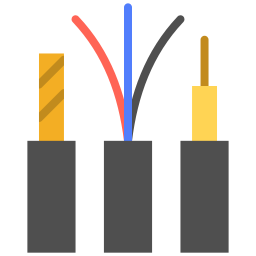
Fiber Optic Cable – Network Hardware Components
Fiber optic cable is one of the most advanced and reliable components in modern network infrastructure. It is a type of hardware used for transmitting data over long distances at incredibly high speeds with minimal signal loss. This technology uses strands of glass or plastic fibers to carry light signals rather than electrical signals, which makes it highly efficient for data communication.
Structure and Composition of Fiber Optic Cable
Fiber optic cables are composed of several layers:
Core: The innermost part where the light travels. It is made from glass or plastic.
Cladding: Surrounds the core and reflects light back into it to prevent signal loss.
Buffer Coating: Protects the fiber from damage and moisture.
Strength Members: Provide mechanical strength and flexibility.
Outer Jacket: The protective layer that shields the internal structure from environmental damage.
Types of Fiber Optic Cables
Single-mode Fiber (SMF): Used for long-distance transmission with a small core diameter, allowing only one mode of light to propagate.
Multi-mode Fiber (MMF): Suitable for shorter distances with a larger core diameter that allows multiple light modes to travel simultaneously.
Applications of Fiber Optic Cable in Network Hardware
Backbone Connections: Used in building backbone infrastructure between data centers, telecom hubs, and enterprise networks.
Internet Service Providers (ISPs): Delivers high-speed internet connections to homes and businesses.
Data Transmission in LAN/WAN Networks: Supports high-bandwidth requirements in both local and wide area networks.
Undersea Cables: Provides international internet and data connectivity across continents.
Military and Aerospace Communications: Offers secure, fast, and interference-free communication.
Medical Equipment: Used in advanced imaging devices and data transfer systems.
Industrial Automation: Transfers control signals in environments where electrical interference is present.
Advantages of Fiber Optic Cable as a Network Hardware Component
High Bandwidth Capacity: Supports much higher data rates than copper cables.
Longer Distance Transmission: Maintains signal integrity over much longer distances without the need for amplification.
Immunity to Electromagnetic Interference (EMI): Since it uses light instead of electrical signals, it is not affected by EMI.
Enhanced Security: More difficult to tap into, making it more secure than copper cables.
Smaller Size and Lighter Weight: Easier to install and manage in tight spaces.
Durability: Resistant to water, temperature changes, and harsh environmental conditions.
Limitations and Considerations
Cost: More expensive than traditional copper cables in terms of initial investment and installation.
Fragility: The glass fibers can be brittle and need careful handling during installation.
Specialized Equipment: Requires specific hardware such as fiber-optic transceivers, connectors, and splicing tools.
Complex Installation: Needs skilled technicians and precise alignment of connectors.
Is Fiber Optic Cable Free or Paid?
Using fiber optic cable is not free. It involves both initial and ongoing costs:
Installation Costs: Includes cable purchase, trenching (if needed), labor, and specialized tools.
Maintenance Costs: Though low in frequency, repairs and replacements are more complex and can be costly.
Operational Costs: Include network hardware compatibility, such as switches and routers with fiber ports.
Service providers who offer fiber optic internet or connectivity services also charge customers based on the speed and bandwidth requirements.
Comparison with Other Network Cables
Compared to coaxial cables, fiber optics provide far higher data transmission rates and longer distance capabilities.
In contrast with twisted-pair cables (like Cat5e, Cat6), fiber optic cables offer superior speed, bandwidth, and resistance to interference.
While copper cables are cheaper and easier to install, fiber optics are more reliable and future-proof for high-demand applications.
Conclusion
Fiber optic cable is a critical component in modern network infrastructure, offering unmatched performance in terms of speed, reliability, and security. Its ability to support high data rates over long distances with minimal signal loss makes it ideal for both commercial and industrial networking environments. Although the initial cost and complexity of installation may be higher than other cable types, the long-term benefits in efficiency, scalability, and reduced maintenance make fiber optic technology a worthwhile investment for any high-performance network.












